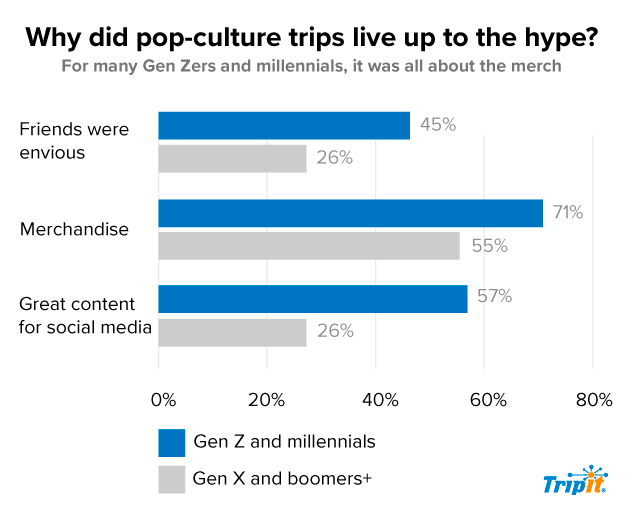
Art. Books. Concerts. Drama (series). Everywhere you look, there’s inspiration for travel in pop culture. And new survey data from TripIt shows Americans are not only soaking up that inspiration, but booking trips to experience said culture firsthand.
According to our survey of 1,000 Americans, pop culture—think: Taylor Swift’s Eras Tour, the College Football Playoff National Championships, and TV shows like Game of Thrones and The White Lotus—is a driving factor behind many 2024 travel plans.
Our data shows that these types of trips are increasing in popularity, too. Less than a quarter (22%) of Americans took a pop-culture trip in 2023, but 40% of Americans are planning one in the year ahead—a year-over-year increase of 82%!
Chances are, you, your spouse, your teenager—and even your boomer+ relatives—are planning a trip inspired by pop culture.
Here’s a closer look at the top trends—and how they’re influencing Americans’ travel plans in 2024.
1. Music motivates Americans to travel—both domestically and abroad
Concert tickets - check! Passport - check! Flights - check!
Sound familiar? It’s the new travel checklist. Indeed, according to new survey data, of those who took pop-culture trips in 2023, two in three (66%) went to a concert or music festival.
“Last year I traveled to Cardiff, United Kingdom to see Beyoncé’s Renaissance World Tour,” said Abigail Akinyemi, travel and lifestyle content creator and solo-travel expert. “I went solo, but I never felt alone. The energy of being in a place with people for a shared event was beautiful.”
Survey data also showed that of those who are planning a pop-culture trip in the near future, more than half (56%) are planning a trip for a music event. Taylor Swift's Eras Tour, in particular, is driving people to travel in 2024: 39% said they are interested or currently planning to attend one of her international shows this year.
Kendyl Grender, budget-travel hacking coach, is one of the many who will travel to see Taylor perform overseas.
“I booked a trip to Amsterdam this summer just for the Eras Tour,” she said. “It’s a cultural phenomenon. There is certainly nothing else like it and probably won't be for a long time.”
But big names—and big venues—don’t appeal to everyone. Our research found that while more than half (56%) of Gen Z and millennial respondents would rather see a global star’s stadium concert, 73% of Gen Xers and boomers+ would rather see a lesser-known artist at a smaller venue.
A similar generational divide exists between those planning to attend music festivals, like Coachella or Lollapalooza, in 2024.
Is it about prioritizing getting more bang for their buck? Millennials nod in agreement. Half (50%) of Gen Y said they’re intentionally choosing to see multiple artists for the price of one music festival, instead of going to individual concerts (45%).
2. Pop-culture trips trend up and to the right—and live up to the hype
While music-related events were the top reason for pop-culture trips, travelers reported other reasons, as well. Nearly half (43%) of respondents traveled for sporting events. Almost a third (28%) traveled to locations from a movie, TV show, or book. For example, Kendyl recently traveled to Croatia to see where Game of Thrones was filmed there. And 16% of respondents were inspired to visit viral social media locations; more on those types of trips a bit further down.
Younger generations are especially keen on pop-culture trips: 59% of Gen Zers and 58% of millennials plan on taking a pop-culture trip in the next year, compared with 35% of Gen Xers and 19% of boomers+.
One reason pop-culture trips are so popular is those who’ve taken them overwhelmingly agree that the experience has lived up to the hype. According to our data, 93% of respondents say their pop-culture trip lived up to their expectations.
Why’d they feel this way? Almost all travelers (94%) said the memories they made during their pop-culture trip helped it live up to the hype. Nearly as many (86%) said that being able to share the experience with someone they love was a reason their trip lived up to their expectations.
Gen Z and millennial travelers, in particular, raved about their pop-culture trips—but their reasons for loving them varied from their older counterparts.

Abigail knows a thing or two about getting great content for social media: “I grew up loving The Cheetah Girls, specifically the second movie when they went to Spain,” she said. “In 2019, I traveled to Barcelona because of the movie—and even staged a photoshoot on the same steps where they had a music number to recreate the scenes with my friends.”
The feeling’s not so mutual, however, for Gen X and boomers+. While the older generations likewise felt their pop-culture trips lived up to the hype, 75% of Gen Xers and 88% of boomers+ said they’d rather share their experiences privately with friends and family versus post about them on social media.
3. Parents partake in pop-culture trips, but moms and dads prioritize them differently
TL;DR: More than half of parents are planning a pop culture-inspired trip in 2024.
According to our data, 51% of parents who have children under the age of 18 living with them plan to go on a pop-culture trip within the next year. That’s up 55% from the past year; one in three parents (33%) said they went on a pop-culture trip in 2023.

And while the vast majority of parents (78%) agreed that the creation of lasting memories was the main reason their pop-culture trip lived up to expectations, there’s differing opinions on how future trips might come to fruition.
When asked about what motivates parents the most to book a pop-culture trip, we found moms and dads don’t agree. Indeed, dads outnumbered moms more than two to one in favor of seeing their favorite sports team play (57% of dads vs. 26% of moms). Meanwhile, nearly three-quarters (74%) of moms want to see their favorite artist perform; less than half (43%) of dads agreed.
So, what would it take to make parents’ pop-culture trip dreams a reality? Help, namely. And that’s mostly coming from moms. Mothers were twice as likely to agree that someone else setting up the travel plans would make their pop-culture trip possible (21% moms vs. 12% of dads). Likewise, moms were twice as likely to agree that securing childcare would afford them a chance to get away: 20% of moms said this versus 9% of dads.
4. Gen Z, millennials, and moms source trip ideas on social media
Where do more than half of Americans source their pop-culture trip inspiration from? Social media. Indeed, 54% of respondents said that social media inspired (their desire for) a pop-culture trip.
“Social media has played a major role in inspiring people to consider pop-culture trips,” said Joy and Hugh Zei, the duo behind travel and lifestyle blog Afrostylicity. “With the rise of people documenting their experiences online, more people are drawn to seeking out similar experiences.”
But, our data shows there’s a clear divide between older and younger generations:

And when it comes to where—exactly—those ideas come from, Gen Z are especially likely to scour Instagram (49%) and TikTok (44%) for inspiration.
There’s a divide between parents, too. Our data shows that nearly two-thirds (64%) of moms find inspiration for pop-culture trips on social media; less than half (44%) of dads do.
Despite the differences between generations and parental titles, one overarching theme rings true: Americans are motivated by pop culture to book trips. Who they see, where they go, how they share their experiences, and how they get inspired may vary, but the desire to see the world through the lens of entertainment is salient—and growing.
Methodology: TripIt partnered with Edelman Data & Intelligence to conduct a 10-minute, quantitative survey between October 27-November 6, 2023, fielded among 1,000 Americans, nationally representative by age, gender, ethnicity, and region. In the survey, pop-culture trips were defined as trips that have been inspired by entertainment, including celebrities, movies, music, television, video games, sports, entertainment news, fashion, various forms of technology, etc. For certain statistics in the report, younger generations (Gen Z and millennial) and older generations (Gen X and boomer+) were combined to accommodate sample size limitations.

